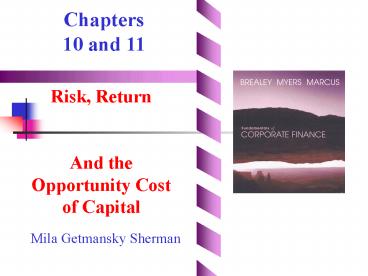Chapters 10 and 11 - PowerPoint PPT Presentation
1 / 25
Title:
Chapters 10 and 11
Description:
Dow Jones Industrial Average (The Dow) Value of a portfolio holding one share in each of 30 large industrial firms. ... of the company's investment projects is ... – PowerPoint PPT presentation
Number of Views:38
Avg rating:3.0/5.0
Title: Chapters 10 and 11
1
Chapters 10 and 11
Risk, Return And the Opportunity Cost of Capital
Mila Getmansky Sherman
2
Topics Covered
- Expected rate of return (cost of capital)
- Risk/return Relationship
- Measuring Risk
- Risk Diversification
- Measuring Market Risk
- Portfolio Betas
- CAPM and Expected Return
- Security Market Line
3
Market Indexes
Dow Jones Industrial Average (The Dow) Value of
a portfolio holding one share in each of 30 large
industrial firms. Standard Poors Composite
Index (The SP 500) Value of a portfolio holding
shares in 500 firms. Holdings are proportional
to the number of shares in the issues.
4
The Value of an Investment of 1 in 1900
Index
Year End
Source Ibbotson Associates
5
Rates of Return
Common Stocks (1900-2001)
6
Measuring Risk
- Variance - Average value of squared deviations
from mean. A measure of volatility. - Standard Deviation - Average value of squared
deviations from mean. A measure of volatility.
7
Measuring Risk
- Coin Toss Game-calculating variance and standard
deviation
8
Risk and Diversification
- Diversification - Strategy designed to reduce
risk by spreading the portfolio across many
investments.
9
Risk and Diversification
Unique Risk - Risk factors affecting only that
firm. Also called diversifiable risk. Market
Risk - Economy-wide sources of risk that affect
the overall stock market. Also called
systematic risk.
10
Risk and Diversification
11
Measuring Market Risk
- Market Portfolio - Portfolio of all assets in the
economy. In practice a broad stock market index,
such as the SP Composite, is used to represent
the market. - Beta - Sensitivity of a stocks return to the
return on the market portfolio.
12
Measuring Market Risk
- Example - Turbo Charged Seafood has the following
returns on its stock, relative to the listed
changes in the return on the market portfolio.
The beta of Turbo Charged Seafood can be derived
from this information.
13
Measuring Market Risk
- Example - continued
14
Measuring Market Risk
Example - continued
- When the market was up 1, Turbo average change
was 0.8 - When the market was down 1, Turbo average
change was -0.8 - The average change of 1.6 (-0.8 to 0.8) divided
by the 2 (-1.0 to 1.0) change in the market
produces a beta of 0.8.
15
Measuring Market Risk
- Example - continued
16
Portfolio Betas
- Diversification decreases variability from unique
risk, but not from market risk. - The beta of your portfolio will be an average of
the betas of the securities in the portfolio. - If you owned all of the SP Composite Index
stocks, you would have an average beta of 1.0
17
Stock Betas
18
Risk and Return
19
Risk and Return
20
Measuring Market Risk
- Market Risk Premium - Risk premium of market
portfolio. Difference between market return and
return on risk-free Treasury bills.
21
Measuring Market Risk
- CAPM - Theory of the relationship between risk
and return which states that the expected risk
premium on any security equals its beta times the
market risk premium.
22
Measuring Market Risk
- Security Market Line - The graphic representation
of the CAPM.
23
Capital Budgeting Project Risk
- The project cost of capital depends on the use to
which the capital is being put. Therefore, it
depends on the risk of the project and not the
risk of the company.
24
Capital Budgeting Project Risk
- Example - Based on the CAPM, ABC Company has a
cost of capital of 17. (4 1.3(10)). A
breakdown of the companys investment projects is
listed below. When evaluating a new dog food
production investment, which cost of capital
should be used? - 1/3 Nuclear Parts Mfr.. B2.0
- 1/3 Computer Hard Drive Mfr.. B1.3
- 1/3 Dog Food Production B0.6
- AVG. B of assets 1.3
25
Capital Budgeting Project Risk
- Example - Based on the CAPM, ABC Company has a
cost of capital of 17. (4 1.3(10)). A
breakdown of the companys investment projects is
listed below. When evaluating a new dog food
production investment, which cost of capital
should be used? - R 4 0.6 (14 - 4 ) 10
- 10 reflects the opportunity cost of capital on
an investment given the unique risk of the
project.































